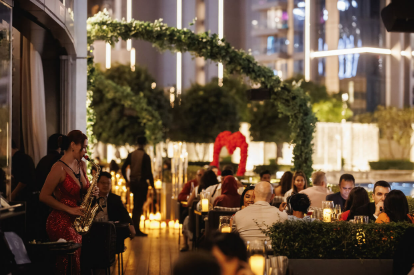The restaurant at the location may be that thing that can make or break your eating experience at the Dubai Mall. Since the number of possible options is in the hundreds, the decision of the incorrect one often leads to disappointment, economic loss, and the loss of an opportunity to engage in special dinners. Some students can self-protect with a bit of preparation and the right knowledge of the possible pitfalls that await many tourists. Knowing about these potential problems, you can make sure that the very process of eating will suit your expectations and you will have pleasant memories regarding eating after it. The suggestion to avoid these mistakes could improve your selection of nice restaurants in dubai mall.
1. Ignoring Peak Hours and Waiting Times
Getting to popular restaurants when they are busy and not accounting for the time spent waiting is one of the worst irritating mistakes that customers may make. The weekends, the evenings, and the holidays usually feature large crowds and the line and the waiting time may even exceed hours. The majority of the tourists do not know that restaurants at the Dubai Mall are extremely busy, particularly during special events, or at dinnertime. This type of mistake has more than one harmful effect, which can be the choosing in a haste or a mixture of less desirable options and even the failure to prepare meals. Intelligent diners visit the restaurant during off-peak periods such as in the early lunch time hours or late in the afternoon or call administration and ask about peak hours at the restaurant.
2. Overlooking Dietary Restrictions and Preferences
As a result of not paying attention to the menu choices of a specific diet necessity, very uncomfortable complications and extremely limited food options occur. Most people just assume every restaurant can meet their dining requirements, be they vegetarian, vegan, halal, or gluten-free, among others, without doing their homework first by checking at the restaurant. By making such an assumption, one can face highly embarrassing experiences in the event that no suitable option is available and compromises or total alteration in venues have to be adopted. The capacity of the restaurants located at Dubai Mall to meet various dietary needs is also diverse, including some being specialized in cuisines you do not prefer. Determining what to order requires effective diners to read reviews by patrons with similar needs, call up a restaurant to ask if there are any dietary changes, or to view menus on the websites of the restaurants.
3. Neglecting to Check Recent Reviews and Ratings
People that visit restaurants often make poor choices relying on inadequate data such as the reputation of the restaurant or on the past due date of information and do not look at the recent reviews. The most recent reviews are also telling when it comes to the latest conditions, e.g., food freshness, awaiting service performance, the standards of cleanness, and overall client satisfaction. Smart consumers refer to a diverse set of review websites, whereby they pay attention to trends in recent posts instead of the aggregate historical ratings. Additionally, they search for detailed feedback regarding the foods they intend to buy, the caliber of the service, and any persistent problems brought up by several reviews. Before choosing a restaurant, this study helps identify possible red signals and helps set reasonable expectations.
4. Underestimating Budget Requirements and Hidden Costs
The mistake of disregarding complete pricing mechanisms, which involve tax, service cost, and other expenses that could cost consumers considerable fees to pay, is also common. Others do not care much about the Dubai normal restaurant service charges on food because they merely focus on the price of the main course. Particularly during busy times or special occasions, several restaurants have minimum spending requirements. Even before they choose a restaurant, effective diners study entire menus including prices, as well as ask about service charges and taxes, and develop their own accurate budgets. In determining the total costs, they also consider the number of people in attendance as well as their appetite to ensure the food consumption process remains within affordable levels.
5. Choosing Restaurants Based Solely on Location Convenience
Neighboring food courts near the entrance of malls and shopping centers often result in fewer meals in high-cost food joints because of the restaurant location factor. With superior food quality, service, and prices away from busy areas, several outstanding eateries can be found in the mall’s less visible sections. Diners miss out on hidden treasures that offer better experiences because of this location bias. Convenience and quality are balanced when choosing a restaurant, and sometimes a little longer walk is worth it for noticeably superior meals. Examining various mall areas frequently exposes excellent eateries that residents love but that visitors usually miss because of their less noticeable placements.
6. Failing to Consider Group Size and Restaurant Capacity
The number of diners fails to check on the size of their party that can be seated at the restaurant they have chosen, which creates tables that are divided or seating that is congested, thus taking a toll on the eating experience. Groups of seven or more (or fewer than four or six in many restaurants) should book in advance so that they are not scuttled. Other cases are where the size of the group is not specified in the process of reservations, and this can result in poor seat arrangement or a delay in the process, as the staff is struggling to reserve sufficient spaces. The practice of investigating restaurant layouts, calling in advance to secure seating options, and maybe splitting up into smaller bands across multiple restaurants is all needed to have a successful group meal.
7. Disregarding Cultural and Dress Code Requirements
Failure to obey the culture and dress code in the restaurants may cause embarrassing scenarios or even rejection, especially in the upscale restaurants where the dress codes are very demanding. Dubai Malls alter their restaurants: on the one hand, there are informal restaurants with a casual dressing code; on the other hand, elegant restaurants with a formal dressing code. In others, they are included in the restaurant policies, which are culturally sensitive issues that a patron ought to observe. Most of the customers, at least, tourists do not live up to these expectations and arrive at the restaurants in clothes that will not fit the restaurant of their choice.
Conclusion
Avoiding these crucial errors turns choosing a restaurant for dinner in dubai mall from a daunting task into a fun experience. Memorable eating experiences are ensured by careful preparation, investigation, and attention to individual needs. Making wise decisions maximizes dining enjoyment while producing outstanding meals, happy groups, and pleasant memories that improve your entire mall experience.

